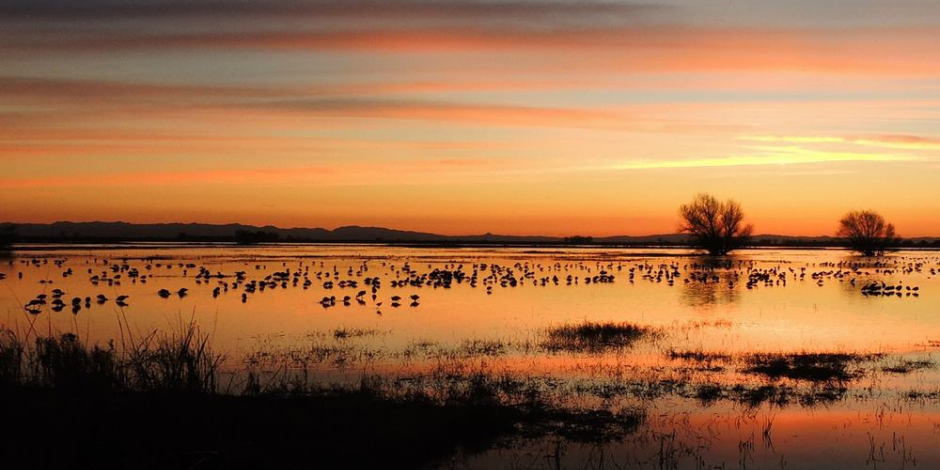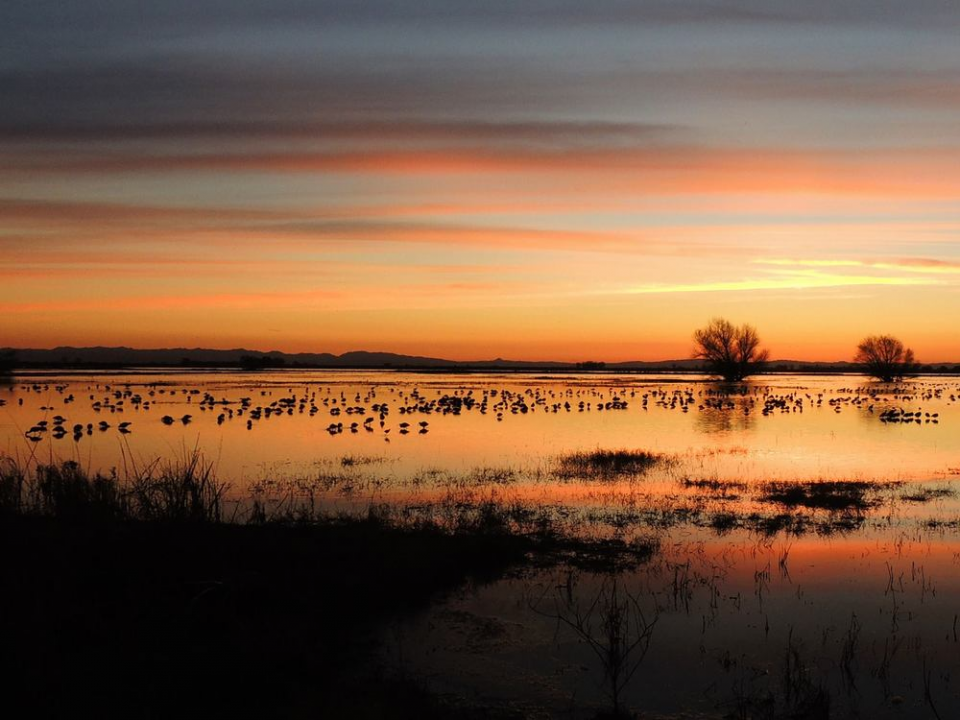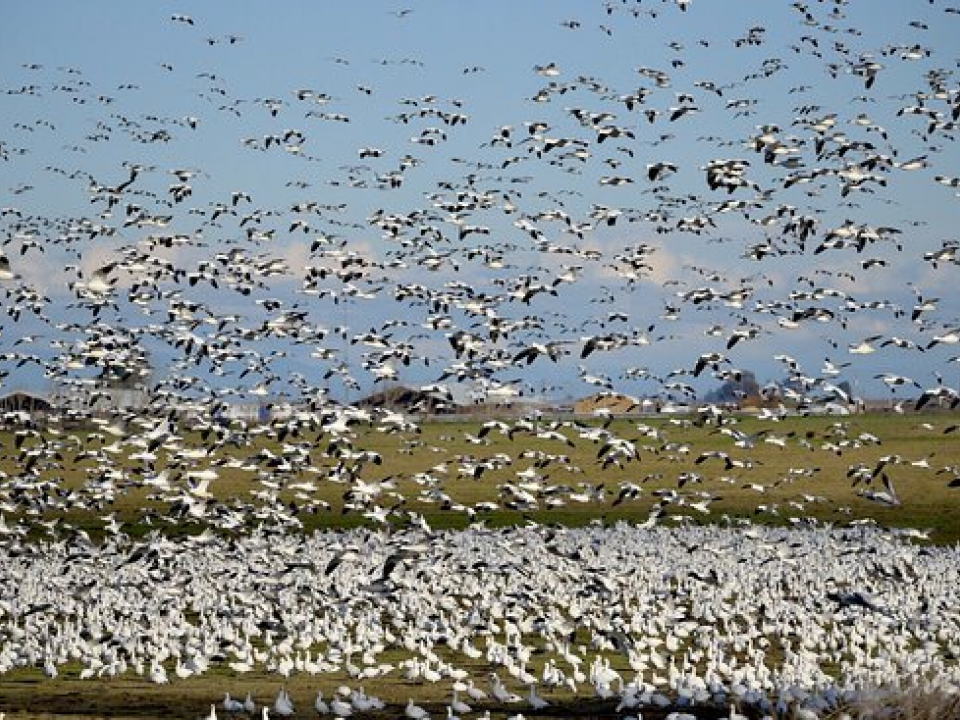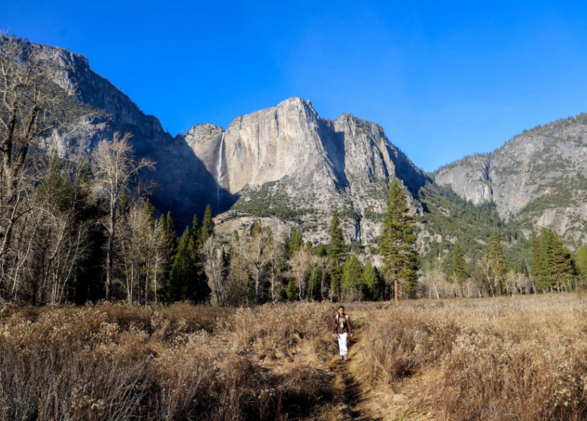Lessons From the Field: California Migratory Birds

In early March, NatureBridge Mentor Teacher Deepak "Deeps" Dathatri organized an incredible birding and wildlife experience for NatureBridge staff at the Merced Wildlife Refuge. Over the course of four hours, the group saw 54 different species including an American White Pelican, a flock of Sandhill Cranes, a large gaggle of Canada Geese and several raptors.
Following the bird watching extravaganza, we caught up with Deepak to get his insight on birding, the Great Pacific Flyaway and California migratory birds. Read what he had to say, including tips for first time birders:
What can you tell us about the California Bird Migration? #
California is one of the best places to experience the incredible migration of wildlife as it is situated right along the Great Pacific Flyway, a principal migratory route for birds. California has preserved a great deal of habitat including Marine Protected Areas along the coast, restored and reclaimed wetlands across the Central Valley and National Park and Forest land across the Sierra Nevada. Birders from all over the world come to California to see this migration and the numerous species that can only be seen in California.
What is the Great Pacific Flyway and what is its significance in relation to the Bay Area? #
The Great Pacific Flyway is the name given to the major migratory route that many birds take to move between the tropics and Canada/Alaska twice each year. Birds don't just migrate in random ways across this country. The Bay Area happens to fall right along this major pathway and, hence, is a prime place to see so many different birds.
The Nature Conservancy named sandhill cranes one of the "Top Five Must-See Migrations in California." Can you tell us more? #
They are likely regarded as among the top "must-see" migrations because they travel several thousand miles twice each year. During the migration period they can travel 350 miles a day, which is incredible considering the energy expenditure that it takes to travel so far and for their size. And, when they migrate, they do so in massive flocks that number in the tens of thousands!
Sandhill cranes are beautiful birds with a six-foot wingspan and are one of the most ancient. The fossil records of these birds date back almost 10 million years, so they are a relatively close descendent of dinosaurs.Mentor Teacher Deepak Dathatri
Sandhill Cranes are very vocal. They make a guttural "croak" which, when multiplied by thousands, makes a cacophony that feels almost deafening if you were to witness it up close. On my recent birding trip to the Merced Wildlife Refuge, we saw relatively smaller flocks that numbered perhaps in the hundreds and it was amazing to see these large, beautiful birds on their stopover in the Central Valley. Definitely a highlight of our birding trip.
What other species were you able to see during your birding expedition? #
During this last birding expedition we were able to see 54 species in just four hours. It's rare to see such a diversity of species in such a short time. Sandhill Cranes were among the highlights.
However, given the wide range of birding experience in the group, each person had their own highlights. For some, seeing Cinnamon Teals for the first time was an amazing experience. For others being able to see Great Horned Owls nesting and up close using a spotting scope was a highlight.
According to the experts, the Pacific Flyway is at risk and many migratory species have been on the decline for several years. Is there anything that bird enthusiasts can do to help? #
The Pacific Flyway, and in fact all migratory routes, are at risk. Perhaps the largest risk to migratory species is climate change. Migration happens in response to seasonal change and since climate change is changing the timing and duration of seasons rapidly, it gives migratory species less time to adapt. Climate change also exacerbates the severity of storms and natural disasters, which can greatly impact migration. Climate change and other forces have also caused a lot of habitat loss for birds.
From humans claiming dominion over land for large-scale agriculture and the use of pesticides to claim that land for humans alone, to the development of manufactured urban environments, birds have lost so much of their habitat—something vital to migration.
When one is connected to something, they are more likely to value it, and when they value it, they are more likely to take steps to protect it.Mentor Teacher Deepak Dathatri
Luckily, California has done a pretty good job of advocating for and maintaining protected land to help preserve this habitat. If people want to help, they can donate to a local Audubon chapter or Land Trusts or Land preservation societies. But, people are not going to even care about protecting birds if they are not connected to them. So, what's most important is to cultivate a personal connection to birds, and to help people build these personal connections from a young age.
What advice would you give to birding first-timers? #
For anyone who is just starting out as a birder, or has reservations about birding, I'd recommend a few things.
- Invest in a pair of quality binoculars or monocular. Having just a pocket 10x25 pair may not give you the experience you're looking for, so spending a bit more, or borrowing a nicer pair from someone will be worth it.
- Buy or borrow a bird identification guide. I like the Kaufman guide to the Birds of North America because it is easy to use, it has digitized pictures of birds, not just illustrations. It starts off with a great explanation on how to use the guide. Range maps are also on the same page as the birds so you don't have to keep flipping back and forth to confirm if the bird you saw actually occurs in your area. When you get slightly more familiar with the various categories of birds, you will have an easier time sifting through the guide to find the bird you're looking for.
- Slow down, and just watch birds and how they behave for a while. It's not a race to get your species list as high as possible. The beauty and wonder of birding is in observing and listening. If you were to carefully observe pigeons for some time, you'll learn so much.
- If you want to go on a birding trip, find someone who has some expertise, but who isn't just going to list off the species they see, possibly to demonstrate how great they are identifying birds. Go with someone who can work with you at your level.
- Finally, I'd recommend trying to go to specific places at certain times of the year. Go to a wildlife refuge during the early part of migration season (mid-February to mid-March). These are the places where you see birds in such incredible quantities and diversity that it will get you hooked!
Seeing a creature that can fly evokes for me childhood dreams of being a superhero. I'm enamored with birds' ability to defy gravity and do it so gracefully.Mentor Teacher Deepak Dathatri
What do you love most about birding? #
Well, it isn't birding that I love, I just love seeing wildlife. Birds just happen to be among the most active, vocal and colorful wildlife which you can see essentially anywhere.
I also have been able to learn so many wonderful, awe-inspiring facts about birds and have learned how complex and surprising they are because I have spent so much time watching them. Birding is a peaceful form of recreation and requires very minimal resources—just your eyes and ears, ultimately. Bird behavior is also incredibly fascinating to me; from elaborate courtship to nesting. Who hasn't marveled at birds' ability to weave a home using a sharp and cumbersome beak?!
With an undergraduate degree from McGill University in Wildlife Biology and Masters in Education from Victoria University of Wellington in New Zealand, Deepak has worked for NatureBridge for a total of 11 years. In between roles at various campuses, he has done avian research on forest songbirds, coordinated the second-year pilot of a program at the Wellington Zoo helping students learn about native biodiversity and worked for a social justice non-profit called City Year. It was at Yosemite that he truly fell in love with the work of teaching environmental science education through NatureBridge. Deepak is currently a Mentor Teacher at our Golden Gate campus in the Marin Headlands.
Stay tuned for more NatureBridge educator insights on wildlife, flora and fauna in this 'Lessons from the Field' series.



